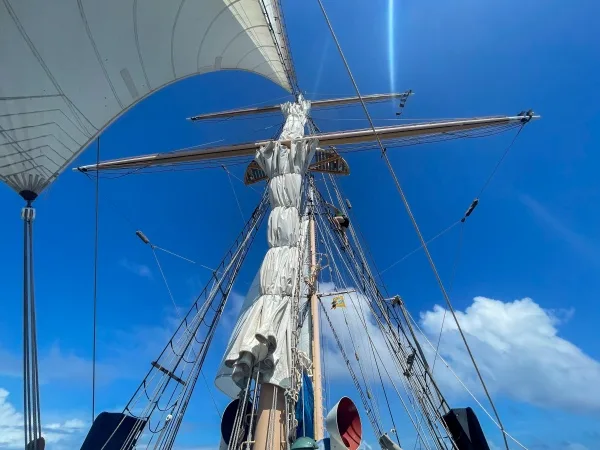Programs Blog
Aloft on the Seamans

Author: Nicholas Romano, University of San Diego
Ship’s Log
Position
11˚30.88’ N x 133˚03.65’ W
Winds
Force 3 from E x N
Log
1686 Nautical Miles
Over the last few weeks we have become very well acquainted with every part of our small city. Our hourly boat checks take us to all corners of the boat, through the storage compartments in the hold and the engine and machinery rooms. However, there has still been one part of the ship that has eluded us, until today. Going aloft and climbing the rigging is a big privilege, requiring a strong grasp of the ship itself and how to stay safe. For this reason there is a lengthy checklist of skills that each person must complete to become eligible to go aloft. Once each person in a watch group completes it, that watch group can then be given their aloft training. My watch, B watch, was the first to accomplish this and today we finally received our aloft training, climbing the rigging for the first time.
On the Seamans, going aloft on the foremast is a voluntary activity, something that is fun to do but by no means a requirement or necessity, something that could not be said on a traditional square rigger. Square sails are traditionally furled on their yards and set by manually releasing them. However, it would take too long for us to accomplish this, as we must strike any square sails that are set each time we stop to deploy our scientific instruments. Instead our square sails are rigged with inhauls and outhauls, enabling them to be furled against the mast and then set and struck quickly and easily from the deck.
Stepping onto the ladder is freaky at first, as you must step up onto the top of the rail and proceed to climb seemingly over the ocean without being clipped into anything. As you get higher the rolling of the boat becomes far more pronounced until at last you reach the small platform halfway up the mast. At this point, 50 feet above the deck, you finally clip in as you transition off the ladder. The view even just from 50 feet is amazing.
Looking back towards the stern of the boat you look down on the helm, filled with activity as the current watch goes about their duties. All around is piercing blue water, stretching down almost 15,000 feet to the seafloor. Every now and then flying fish break free from the surface and glide for a moment before splashing back down into the rolling swells.
Being on the foremast, you have a great view looking down onto the head rig and the bowsprit, watching as the ship cuts through the waves. Normally we would have climbed higher still, but the seas were rough and the ship was rolling a bit too much to make it a comfortable climb. As we stood at the foot of the lower yard we were regarded curiously by a few Boobies that had taken a break from the mornings hunt for flying fish. For these birds, without any predators on the high seas, we were a mere curiosity far more than any threat.
It was truly exhilarating being able to climb above and look back down at our little city in the vast blue, and a little humbling as well. We are covering roughly 100 nautical miles a day, and we are over 1,000 nautical miles to the nearest piece of land. These numbers can seem abstract at times when looking out at our usual vista of ocean, but somehow felt more tangible just by getting a new perspective on the world. This most recent stretch of the journey has been my favorite, once we dipped into the tropics. The sheer volume of life out here is incredible, from the constant stream of flying fish to the incredible bioluminescence each night.
Unfortunately though the fishing has been slow, with just the one Mahi Mahi (it did taste amazing though). Finally, way to go Team Turkey for crushing it on Thanksgiving! Gobble Gobble
Mom, Dad, and Joshua: Happy belated Thanksgiving! Mom, Happy (slightly) belated Birthday, and finally, Happy Birthday, Dad!
– Nicholas Romano, University of San Diego
Contact: Douglas Karlson, Director of Communications, 508-444-1918 | [email protected]
Recent Posts from the Ships
- SEA Writer 2022, Magazines From the Summer SEA Quest Students
- PIPA Alumni Reconnect with Children of Kanton
- Woods Hole Welcomes Incoming Class of PEP Students
- Muhlenberg Student Finds Perfect Study Abroad Experience with SEA Semester
- SEA Student Describes Pacific Exploration for University of Denver News
Programs
- Gap Year
- Ocean Exploration
- High School
- Science at SEA
- SEA Expedition
- SEAScape
- Pre-College
- Proctor Ocean Classroom
- Protecting the Phoenix Islands
- Sargassum Ecosystem
- SPICE
- Stanford@SEA
- Undergraduate
- Climate and Society
- Climate Change and Coastal Resilience
- Coral Reef Conservation
- Marine Biodiversity and Conservation
- MBL
- Ocean Exploration: Plastics
- Ocean Policy: Marine Protected Areas
- Oceans and Climate
- Pacific Reef Expedition
- S-299 Summer Session
- The Global Ocean: Hawai'i
- The Global Ocean: New Zealand